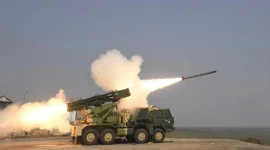- Views: 2K
- Replies: 1

In a significant shift in naval strategy, India is prioritizing the development of nuclear-powered attack submarines (SSNs) over a third aircraft carrier. This move comes as a direct response to the increasing presence of Chinese warships and surveillance vessels in the Indian Ocean Region (IOR).
Earlier this month, the Narendra Modi government approved the construction of two SSNs, signaling a clear focus on sub-surface deterrence. This decision reflects a growing concern that aircraft carriers are becoming increasingly vulnerable to China's advanced long-range missiles.
The need for enhanced underwater capabilities is underscored by the consistent presence of Chinese vessels in the IOR. Since 2023, an average of 10 Chinese warships, including ballistic missile trackers and surveillance ships, have been deployed in the region each month.
Currently, the Chinese surveillance ship Xiang Yang Hong 3 is operating off the coast of Chennai, while the ballistic missile tracker Yuan Wang 7 is stationed off the coast of Mauritius. With the People's Liberation Army (PLA) Navy planning to expand its carrier-based task forces and long-range patrols, this presence is only expected to grow.
To counter this threat, India is bolstering its submarine fleet. In addition to the two newly approved SSNs, the Indian Navy is set to receive a second Akula-class nuclear attack submarine on lease from Russia by 2028, despite delays caused by the ongoing conflict in Ukraine.
Furthermore, India's indigenous nuclear ballistic missile submarine (SSBN) program is making steady progress. The third SSBN, INS Aridhaman, is scheduled to be commissioned next year, joining INS Arihant and INS Arighat in providing a credible nuclear deterrent. These submarines are equipped with a mix of K-15 and K-4 nuclear ballistic missiles, with the latter boasting a range of 3,500 km.
This strategic shift also highlights a change in India's primary security concerns. While Pakistan remains a regional rival, China's increasing assertiveness, particularly following the 2020 border clashes in eastern Ladakh, has solidified its position as India's principal adversary. With crucial trade routes to East and North Asia passing through the IOR, securing these sea lanes has become a top priority for Indian security planners.
While India continues to invest in conventional diesel-electric submarines, such as the Scorpene class, these are primarily intended for regional threats and export potential. The focus on nuclear submarines, both SSBNs and SSNs, clearly indicates that India views these vessels as crucial for maintaining a strategic edge in the Indo-Pacific region and deterring Chinese aggression.



